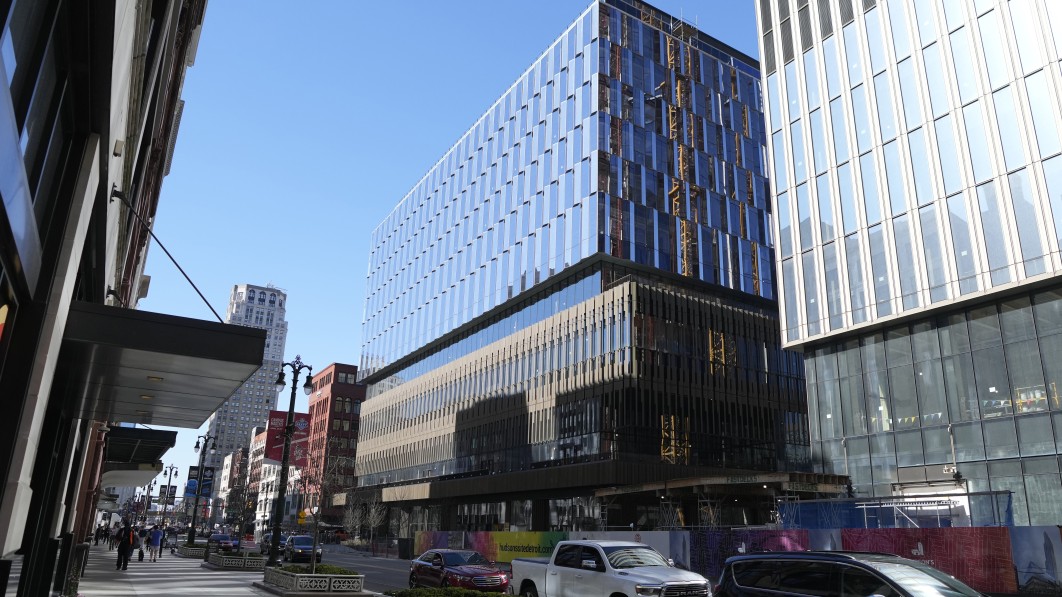Back in 2018, Chevy invited me to attend the Detroit Auto Show on the company dime to get an early preview of the then-newly redesigned Silverado. The trip involved a stay at the Renaissance Center — just a quick People Mover ride from the show. I’d been visiting Detroit in January for nearly a decade, and not once had I set foot inside General Motors’ glass-sided headquarters. I was intrigued, to say the least.
Thinking back on my time in the buildings that GM will leave behind when it departs for the new Hudson’s site on Woodward Avenue, two things struck me. For one, its hotel rooms are cold in January. Sure, it’s glass towers designed in the 1960s and ’70s; I calibrated my expectations accordingly. But when I could only barely see out of the place for all the ice forming on the inside of the glass, it drove home just how flawed this iconic structure is.
My second and more pertinent observation was that the RenCen doesn’t really feel like it’s in a city at all, much less one as populous as Detroit. The complex is effectively severed from its surroundings by swirling ribbons of both river and asphalt. To the west sits the Windsor tunnel entrance; to the east, parking lots for nearly as far as the eye can see. To its north is the massive Jefferson Avenue and to its south, the Detroit River. You get the sense that if Henry Ford II and his team of investors had gotten their way, the whole thing would have been built offshore with the swirling channel doubling as a moat. This isn’t a building the draws the city in; it’s one designed to keep it out.
Frost on the inside of the RenCen hotel glass.
Contrasted with the new Hudson’s project GM intends to move into, a mixed-use anchor with residential, office, retail and entertainment offerings smack-dab in Detroit’s most vibrant district, the RenCen is a symbol of an era when each office in Detroit’s downtown was an island in a rising sea of dilapidation. Back then, those who fortified against the rapid erosion of Detroit’s urban bedrock stood the best chance of surviving. This was the era that brought us ugly skyways and eventually the People Mover — anything to help suburban commuters keep their metaphorical feet dry. The RenCen offered — and still offers — virtually any necessity and plenty of nice-to-haves, all accessible without ever venturing outside, especially in the winter, but those enticements are geared to those who trek in from suburbia to toil in its hallways.
GM hasn’t always tried to isolate itself from the city that built it. The company has a history of strategic spending in Detroit. Not long after the RenCen rose on Detroit’s riverfront, GM dropped some decent coin sprucing up around its previous headquarters in the New Center neighborhood — another along the Woodward Avenue corridor. Among the jewels in the “New Center Commons” redevelopment effort was Detroit’s only car-free residential street, Pallister Park. The street itself is restricted to pedestrians, though each of the restored homes has a garage fronting an alleyway. Hey, it’s General Motors, not General Sneakers.
Even after packing up for the RenCen in 1996, GM’s investment in New Center continued to fortify the community against the blight that crept through surrounding neighborhoods. To this day, it provides convenient housing for employees of neighboring Henry Ford Hospital and the occupants of GM’s old headquarters building on West Grand Boulevard, not to mention the surrounding arts and business districts, which include Detroit icons such as the Fisher Building and Motown Museum. GM left Cadillac Place in 2001, but those investments helped keep the area alive — thriving, even — to this day. Ford hopes to do something similar with its investment in Corktown centered on Michigan Central Station, which it is rehabilitating.

The view east from the RenCen hotel, January 2018.
The city is hard at work trying to stitch what remains of its tattered neighborhoods back into a broader urban quilt. New Center Commons didn’t just prop up a couple of failing residential streets; it helped keep surrounding attractions and historic districts from being lost to Detroit’s seemingly ceaseless rhythm of bust cycles. While the commercial real estate strategy of establishing suburban embassies like the RenCen in populated downtowns may have been appealing in the 1970s and ‘80s, the Detroit of today needs fewer RenCens and more New Centers and Michigan Centrals. It certainly needs more Hudson’s.
Detroit needs a strong downtown to subsidize the remains of its far-flung single-family neighborhoods — neighborhoods that were built on the framework of tightly interwoven public transit networks that evaporated as the car voraciously overtook the train as America’s favorite mode of rapid transportation. Eventually, many Detroiters packed those same cars and departed the city permanently, with nobody to replace them. Urban space itself is like a car. The less you use it, the less dependable it becomes, and a city depends on its land to generate more tax revenue than it costs to maintain. Projects like Hudson’s are the treatment for Detroit’s poisonous expanses of empty space. Build enough of them, and it becomes a full-blown antidote.
In the Renaissance Center, GM could sit by comfortably while the world around it burned. By moving across Jefferson into downtown, GM is throwing in its symbolic lot with the city itself. It’s an honorable gesture, and hopefully one that will be recognized by others looking for a new home base. The NFL Draft was no fluke. Detroit is once again on the move. It’s heartening to see that GM is along for the ride.

